You’re viewing an email from my weekly fitness newsletter, the Vitamin. Every week I drop some knowledge bombs on your face to help you reach your goals quicker while avoiding all the bullshit.
Not already subscribed? Well, let’s fix that. Drop your name and email address below, and you’ll get the next issue sent to your inbox via some tech voodoo I don’t really understand.
No spam. Ever. Unsubscribe at any time.
8 July 2021 | by Aadam
Hey,
It’s time for another instalment of the Vitamin––the weekly fitness newsletter that helps you be healthier, stronger, and leaner while navigating fitness bullshit.
THURSDAY TIDBIT
Adaptive Thermogenesis: Does Weight Loss ‘Damage’ Your Metabolism?
As you lose weight, a number of adaptations take place in the body to reduce your daily energy expenditure.
Most of these adaptations are normal and to be expected. For example, a smaller body burns fewer calories than a larger body, so the energy required to maintain your weight at the end of a diet will be less than the amount of energy needed to maintain weight at the start.
A smaller body also means you burn fewer calories when exercising. You’re also eating fewer calories, so the thermic effect of food (TEF)––the energy used to digest food––is also reduced.
Anyone who’s dieted for long enough can attest to the fact that energy levels drop. You start to move around less, both consciously and subconsciously. This can have a knock-on effect on non-exercise energy expenditure (NEAT), the component of your metabolism that refers to all the activity that isn’t formal exercise. 1 2
But there’s one adaptation that’s been at the centre of much controversy: Adaptive thermogenesis.
Adaptive thermogenesis (AT) is a greater than predicted drop in metabolic rate after weight loss, beyond what should be expected based on fat and fat-free mass changes.
For example, if someone loses weight and the expected drop in metabolic rate was 100 calories, the actual drop in metabolic rate might end up being 150 calories. Those additional 50 calories (beyond what was expected) is adaptive thermogenesis.
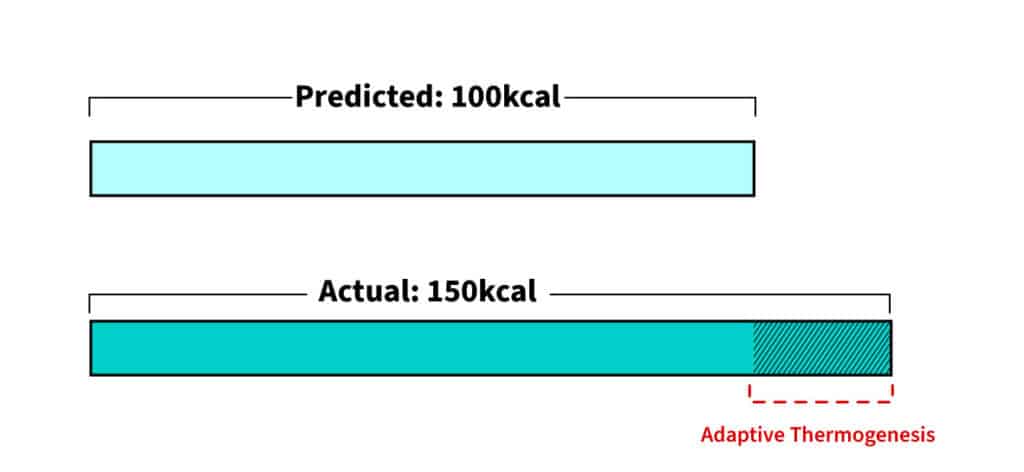
Some studies have suggested that adaptive thermogenesis causes people to regain weight after weight loss and makes long-term weight maintenance harder. 3 4 5 Other studies––one which was covered in a previous issue of the Vitamin––have questioned these results. 6 7
Recently, a group of researchers conducted the first systematic review to determine whether adaptive thermogenesis occurs after weight loss in adults before and/or after a period of weight maintenance.
What did the researchers do?
The researchers included papers published in peer-reviewed journals on or before May 15th 2020, that reported weight loss induced by diet-only, exercise-only, diet and exercise, and bariatric surgery.
A total of 33 studies were included in the final review, with 2528 participants.
What did the researchers find?
27 of the 33 studies reported significant values for adaptive thermogenesis.
Diet-only
15 studies found significant adaptive thermogenesis. Only 3 studies didn’t report significant adaptive thermogenesis after weight loss. It’s worth mentioning adaptive thermogenesis disappeared in studies that measured it after a period of weight stabilisation (this is an important point I’ll return to later).
Exercise-only
There was only one study that used an exercise-only intervention, and it failed to find adaptive thermogenesis. This could have been because the participants lost a small amount of weight (between 1.3–4kg/~3–8lbs).
Exercise + diet
In total, 6 studies used an exercise + diet intervention. Two studies used cardio-only, one used resistance training-only, and three used a combination of resistance training and cardio.
Adaptive thermogenesis ranged between ~30–100kcal in four studies. Two studies reported adaptive thermogenesis between 200-292kcal, and one of these found the value to increase to ~500kcal at follow-up.
Bariatric surgery
4 out of 6 studies reported significant adaptive thermogenesis, though AT disappeared over time. Adaptive thermogenesis was slightly lower in gastric band surgery versus sleeve gastrectomy or Roux-en-Y gastric bypass.
Practical applications
This systematic review found that weight loss leads to adaptive thermogenesis. However, there was high variability between studies: Some studies reported significant adaptive thermogenesis while others reported small or non-significant adaptive thermogenesis.
Interestingly, the studies that used higher-quality methodology and design were also the studies where adaptive thermogenesis was small or non-significant. In particular, there are two factors to be aware of that can greatly skew the values found for adaptive thermogenesis.
1- Not taking measurements during weight stabilisation
The metabolism is sensitive to energy balance changes: a calorie deficit induces a drop in metabolic rate, but this is reversed once calories are increased to maintenance (or above).
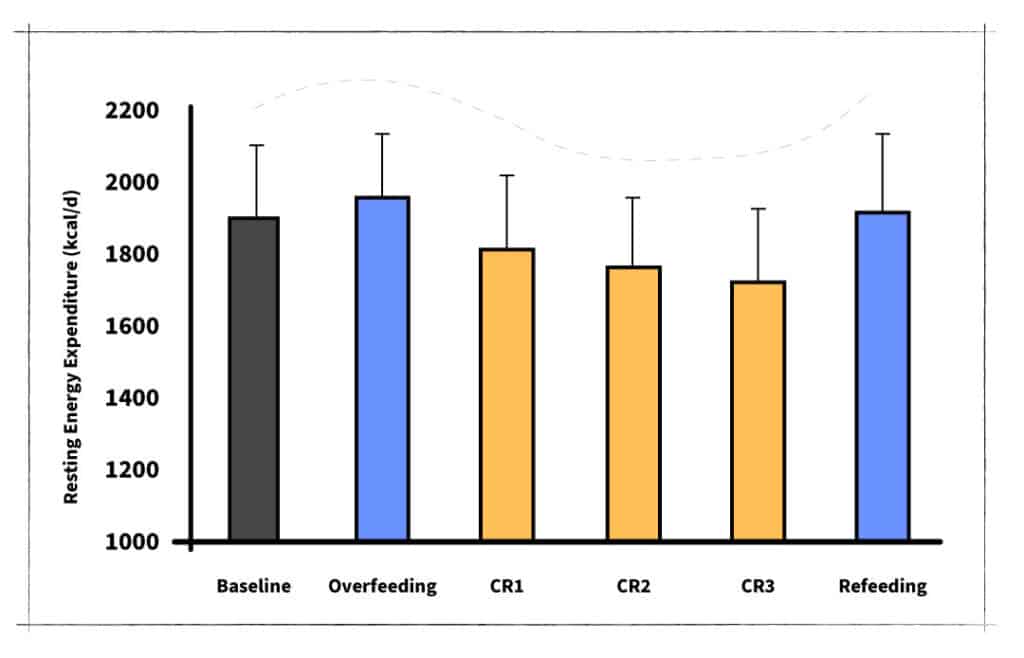
One study measured resting metabolic rate immediately after a 2-month weight-loss period where participants had lost ~14kg (~30lbs). Their resting metabolic rate (RMR) was ~92kcal below what was predicted. But when the researchers measured RMR again four weeks later––after the participants’ weight had stabilised at the new bodyweight––adaptive thermogenesis had halved to ~38kcal.
The “Biggest Loser” study (the only study by the way that found significant adaptive thermogenesis of ~500kcal) had the same issue. In the first study, researchers took measurements at the end of the 30-week competition where the participants were clearly in a deficit. Six years later, the researchers followed up with the participants and, as the image below shows, some of the individuals lost weight in the two weeks leading into testing while others gained weight. This fact alone casts doubt on the results.
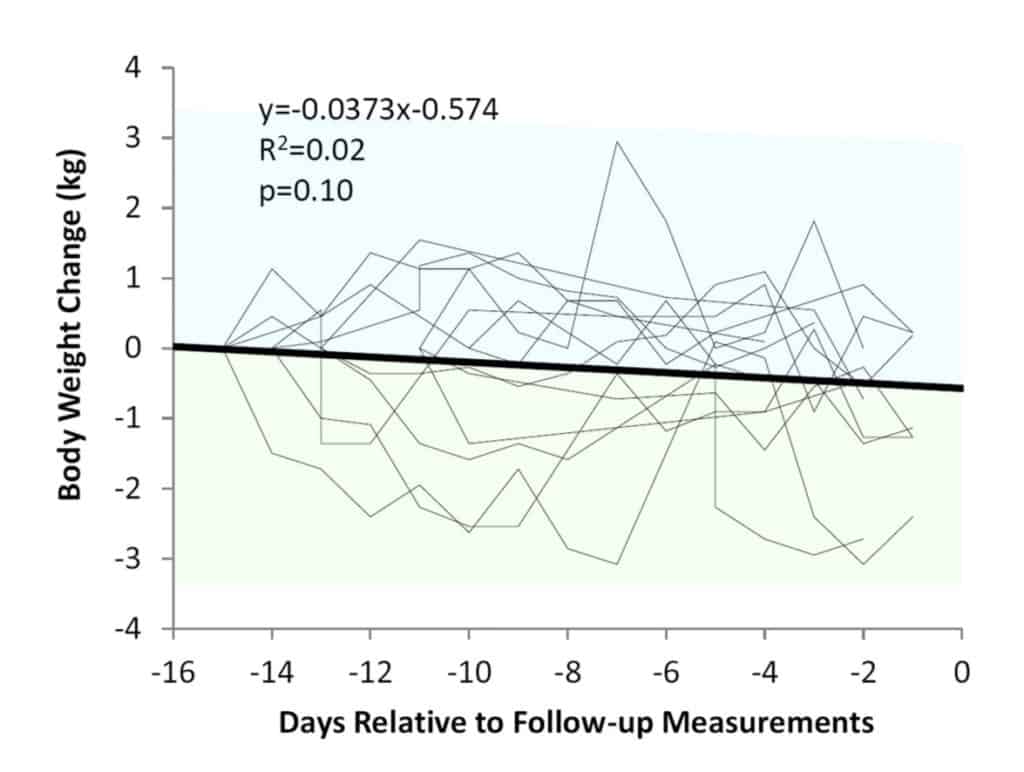
Three studies measured adaptive thermogenesis during weight maintenance in the present review, and all three found adaptive thermogenesis to be greatly reduced or statistically non-significant.
2 – How body composition is assessed
To get the most accurate representation of body composition, you’d use the 4-compartment model, where the body is divided into fat mass, fat-free mass, water and bone mineral content.

Unfortunately, due to cost, researchers instead opt for a 2-compartment model where the body is divided into fat– and fat-free mass.

But the problem with the 2-compartment model is that ‘fat-free mass’ isn’t just muscle––It also includes water, glycogen, and other metabolically active organs like the brain, heart and liver.
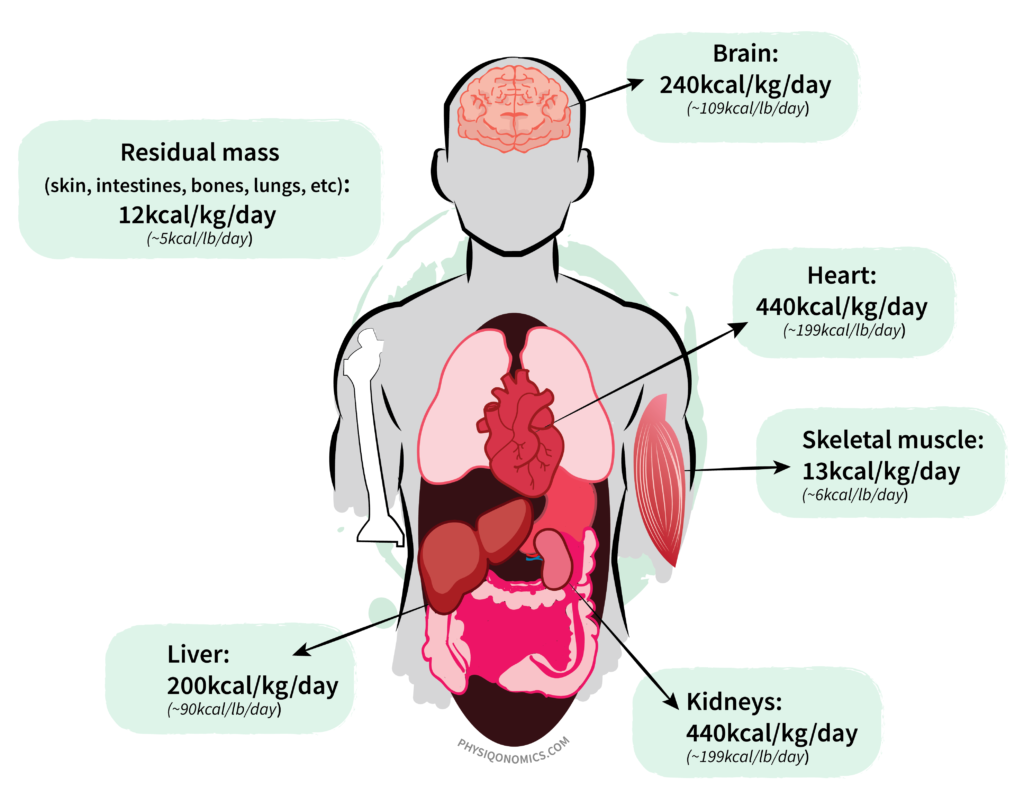
If all of these factors aren’t accounted for, adaptive thermogenesis can be overestimated. And in some cases, by a lot.
Bosy-Westphal and colleagues found adaptive thermogenesis to be about ~300kcal/day after weight loss when basing it on only fat– and fat-free mass. When they assessed adaptive thermogenesis using a %fat-mass equation, adaptive thermogenesis reduced to only ~120kcal/day.
In the present review, studies that assessed adaptive thermogenesis using MRI (one of the most accurate ways to assess body composition) reported low or non-significant values.
So what to make of all of this?
There probably is some adaptive thermogenesis that occurs during weight loss which dissipates once you return to maintenance, and the higher-quality studies seem to support this.
Looking at the literature as a whole, it seems the biggest adaptation to weight loss occurs not in the resting metabolic rate but rather in the NEAT component of the metabolism.
In one study, researchers found resting metabolic rate decreased but plateaued after 10% weight loss. Meanwhile, non-resting energy expenditure continued to decrease until the end of the study.
This is supported by several other studies like the famous Minnesota Starvation Experiment, where 36 men were put on a 24-week starvation diet. By the end of the study, their metabolic rate had dropped by a whopping ~40% (or ~600kcal/d). But only 15% of this was from the resting metabolic rate; most of the reduction was from NEAT.
In fact, NEAT can account for as much as 85-90% of the decline in total energy expenditure in weight-reduced individuals.
Of course, this isn’t to say some people won’t experience more adaptive thermogenesis than others. Ostendorf and colleagues found large interindividual variability in adaptive thermogenesis in weight-reduced individuals ranging from –257kcal/day to +167kcal/day––the more weight lost, the higher the adaptive thermogenesis.
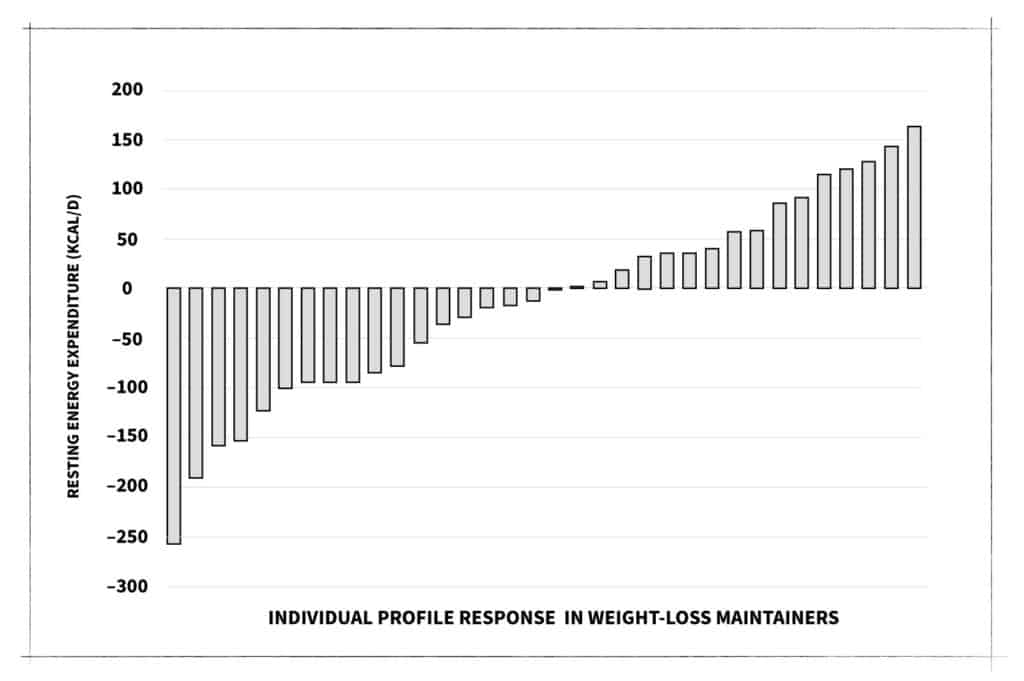
Even so, the extent of adaptive thermogenesis had no bearing on the individual’s ability to maintain weight loss.
This isn’t surprising when you understand resting metabolic rate is only one component of your total daily energy expenditure (TDEE), and it alone can’t dictate whether you gain or lose weight.
For example, people who successfully maintain their weight have higher physical activity levels than normal-weight or overweight and obese individuals who have never lost weight.
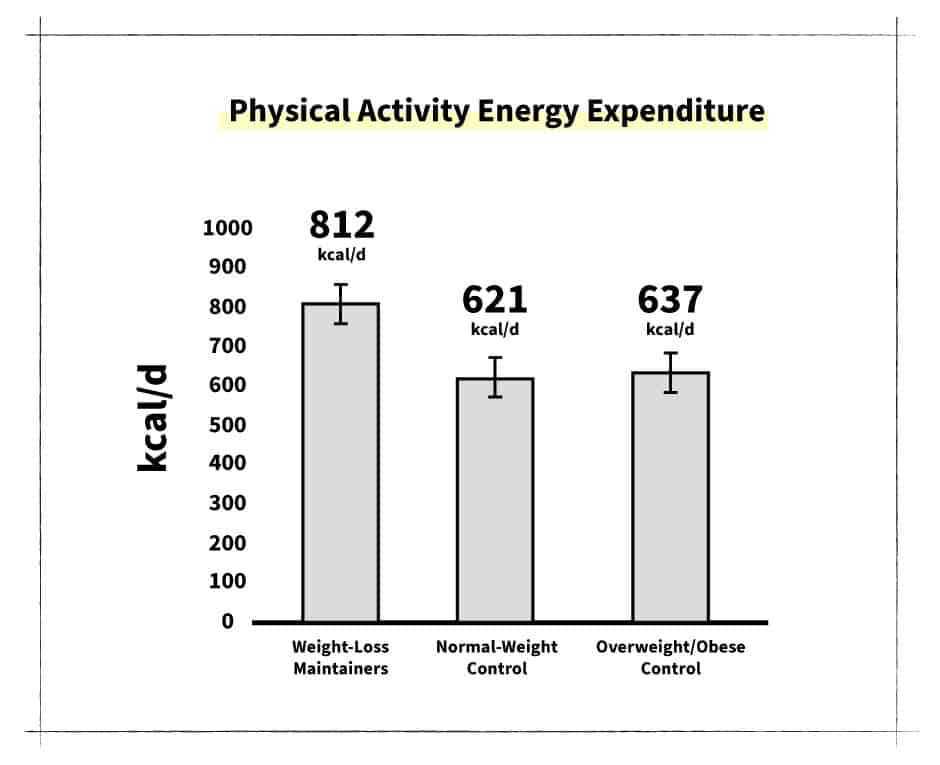
Weight-loss maintainers also take more steps than normal-weight or overweight/obese individuals.
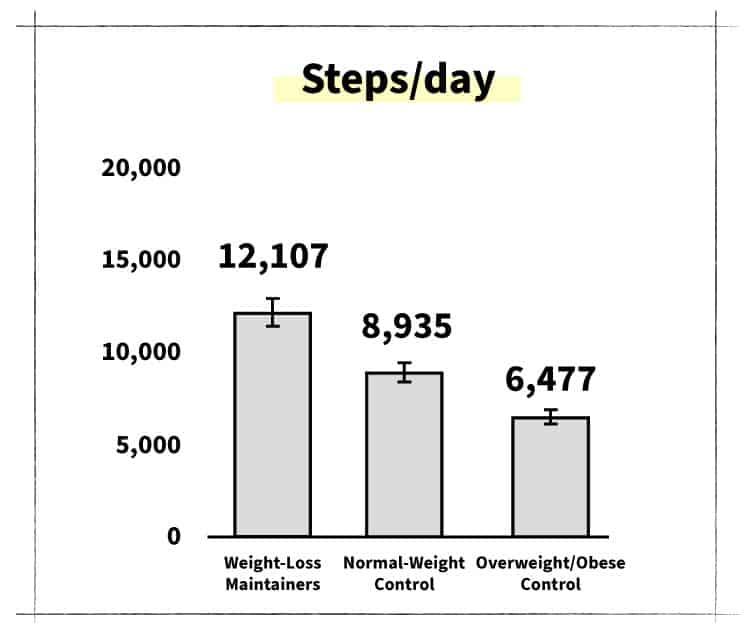
Even in the ‘Biggest Loser’ study, weight regain wasn’t associated with adaptive thermogenesis: Those who kept off the most weight also had the greatest increase in physical activity.
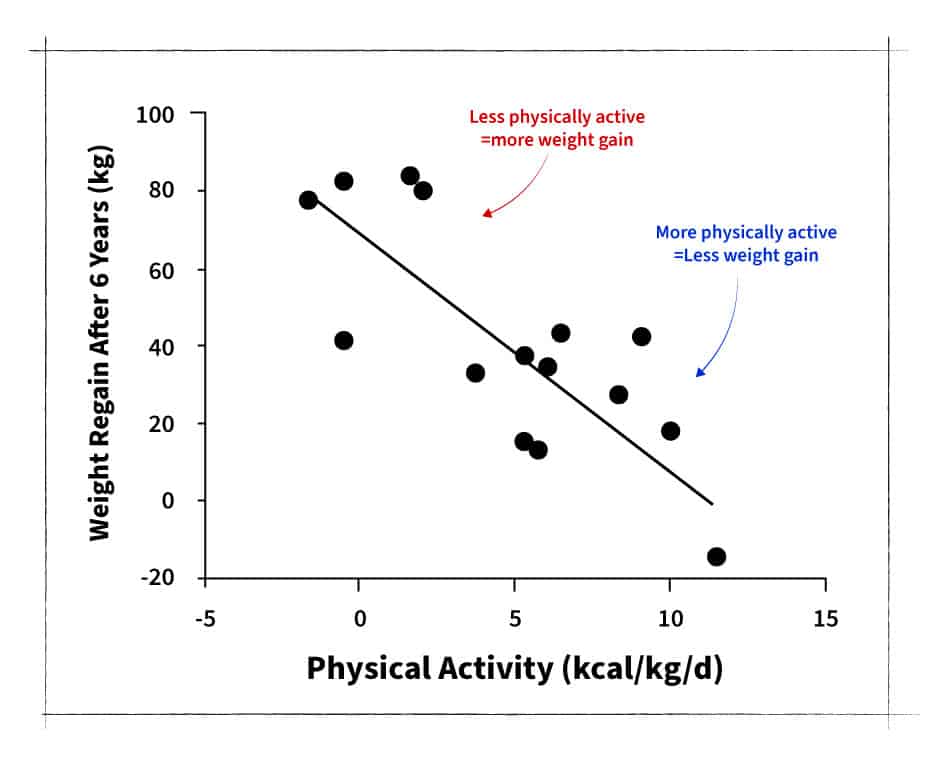
And a 2018 paper looked at strategies employed by successful weight loss maintainers that counteracted metabolic compensation (i.e., adaptive thermogenesis) following weight loss. The researchers write:
Weight-reduced women had similar RMR (adjusted for fat-free mass) compared with controls with no weight-loss history. Increased physical activity, higher protein intake and greater lean muscle mass may have counteracted weight loss-associated metabolic compensation and highlights their importance in weight-maintenance programmes. (Emphasis mine.)
Speaking of protein, other studies have found higher protein intakes are associated with less weight regain in overweight and obese participants. And the weight that is gained tends to be fat-free mass. 8 9
Of course, we can’t mention protein without also mentioning the importance of resistance training. If you’re reading this, then you’re already aware of how important resistance training is for muscle retention during a deficit, and I won’t belabour the point.
There’s no denying that some adaptive thermogenesis occurs during weight loss. And even after weight loss, some of this may persist. Even then, unless you’ve lost a lot of weight, adaptive thermogenesis will be so small that it’s not going to influence weight maintenance. And in most instances will dissipate once you return to maintenance.
As I mentioned above, the biggest adaptation seems to occur in the NEAT component of the metabolism. And fortunately, you do, to some extent, have control over this.
To slightly amend a popular quote: Genetics load the gun, but your habits and behaviours pull the trigger.
Instead of worrying about things out of your control (like adaptive thermogenesis), be more concerned about the things you can control because the things under your control are the things that will help you make and later maintain progress.
Note: this week’s email was taken from The Vitamin––a monthly publication for PLTNM members where Colby Sousa––the chief science officer at Physiqonomics––and I review new studies relevant to Physiqonomics readers and provide breakdowns like this week’s email. If you enjoyed this and want more content like it, check out PLTNM and also get access to training programs, lessons, recipes, and a host of other cool stuff. You can get all the details and start your free trial here.
Thanks for reading. If you enjoy my weekly emails, please consider telling others.
A lot of time and effort goes into writing these weekly emails to make them as helpful as possible for you.
If you enjoy and find value in them, it would mean a lot to me if you could let others know about the Vitamin. It helps Physiqonomics grow and keeps me motivated to continue writing the content you love.
You can share on Facebook, Twitter, WhatsApp, or email.
–Aa